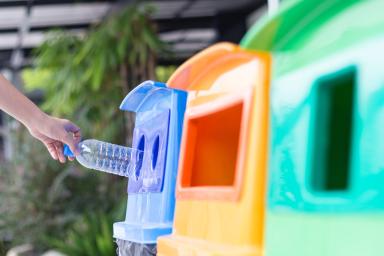How technology can help your business be net zero
Sustainability, net zero and reducing your start-up’s carbon footprint are becoming important issues for business owners.
From cutting down on waste to reducing the amount of miles travelled for business, many small changes can lower harmful greenhouse gas (GHG) emissions.
One area to focus on is how technology and IT equipment are used effectively to reduce energy usage.
The move towards sustainability is being driven in part by the government’s pledge for the UK to become a net zero nation by 2050.
With 67% of micro-business owners having never sought information on how to reduce their carbon footprint according to Start Up Loans research, there’s plenty for small firms to do to help tackle climate change and reduce carbon emissions.
Carbon reduction initiatives
There are a number of initiatives targeting smaller businesses and start-ups to help reduce carbon emissions, primarily related to energy use.
The government has introduced its Together for our Planet campaign, which encourages small businesses to take a leading role in combating climate change.
Organisations such as the UK Business Climate Hub and the Federation of Small Businesses are encouraging firms to make sustainable changes.
One area where these changes can be made is through more effective use of technology in the workplace, lowering energy usage and investing in IT that can replace energy-intensive equipment.
Sustainable IT: what is it, and why is it important?
Sustainable IT is determined by how businesses reduce the impact of IT equipment, such as office electronics, through to industrial equipment and plant.
There are several ways IT equipment can harm the environment:
- Electronic waste – IT equipment can contain waste that is harmful to the environment, from plastics to toxic materials such as batteries. Electronic waste must be recycled appropriately.
- Energy usage – much of our technology can consume energy needlessly, such as operating when not in use or using older, inefficient IT equipment.
- Materials consumption – IT equipment can require significant resources and energy to manufacture and transport, including rare earth materials. They may rely on polluting industries such as mineral mining, shipping, plastics creation and international freight transportation.
Adopting a more sustainable approach to IT equipment through reduced usage and schemes such as recycling, upcycling, and reuse can help reduce their environmental impact.
Encouraging staff to change behaviours, such as switching off computers and monitors, may also reduce emissions.
Saving energy can also benefit a start-up’s bottom line too.
Lower energy bills, less capital expenditure on equipment and more efficient IT use, may help save money and increase profits.
How to reduce the environmental impact of IT
There are small changes you can make in the workplace that can help.
From outsourcing IT needs to simply switching unused equipment off, here are seven ways you can get started:
1. Conduct an energy audit
Consider conducting an energy audit of all the equipment in your workplace, such as computers, printers and monitors.
Many devices will include energy usage in their specifications, or you can use data from organisations such as the Centre for Sustainable Energy.
Make a note of how often devices are left on throughout the day and overnight, such as printers and monitors.
From your analysis, calculate how much energy your start-up is using with IT and how much this is costing your business.
Many energy companies have help and advice on understanding how to calculate energy costs.
2. Switch off devices
One of the easiest ways your start-up can be more energy efficient is by switching off any devices at the plug that aren’t in use.
Unused electronic devices could lead to an increase in your business’ energy output and contribute to higher energy bills.
Good candidates for switching off include PCs, printers and monitors before leaving the premises at night.
Unplug devices such as electric fans or heaters, meeting room projectors or TVs.
Unplug kettles and switch off dishwashers.
3. Recycle and reuse devices
Buying new equipment for your business may be a necessity, but consider recycling or reusing older devices.
Consider repurposing older technology such as PCs into servers.
Update software and components such as memory and storage to extend the life of equipment.
If you do need to dispose of older equipment it might be a welcome donation to another business or organisation.
Use recycling facilities to ensure IT equipment is correctly disposed of.
3. Outsource data storage
Data storage equipment such as hard drives and network drives, especially older drives with spinning hard drive platters, can require a constant supply of energy.
Consider outsourcing your data to external storage companies.
Major IT businesses offer smaller companies access to inexpensive cloud-based data storage.
This means you can ditch workplace solutions, and you’ll only be consuming energy during the times you are accessing the data services.
4. Use sleep timers and screensavers
Many modern computers, laptops and tablets have energy-saving features such as sleep and screensavers.
Set these to activate after a short period, including putting hard drives to sleep.
This can be useful when employees are on a break or when they leave the workplace overnight.
5. Encourage paperless working
Workplace printers not only consume energy, but office printer ink may contain harmful chemicals that can pollute the environment if they reach landfill.
Printing can also require significant amounts of paper, which takes energy to produce and transport.
Encourage staff, suppliers and customers to go paper-free.
Send all invoices and receipts electronically, use digital filing and document systems, and consider using mobile phone cameras to take pictures of documents rather than using a scanner.
6. Choose energy-efficient equipment
If your start-up has to invest in IT equipment, consider looking for the most energy-efficient solution.
Many gadgets and devices in the UK have to include an energy rating, which uses a grading system so you can compare energy efficiency across products.
7. Encourage staff to make a change
Highlighting the benefits of more efficient energy use and the everyday changes employees can make can help your workplace become more sustainable.
Consider providing tips and advice, or introduce workplace policies such as switching off IT equipment when not in use, to help support change.
Learn with Start Up Loans and help make your business born sustainable.
Thinking of starting a sustainable business? Check out our free online courses in partnership with The Open University on environmental decision-making and how organisations impact the environment.
Our free Learn with Start Up Loans courses include:
Plus free courses on climate and sustainability, teamwork, entrepreneurship, mental health and wellbeing.
Tags related to this content:
Disclaimer: The Start -Up Loans Company makes reasonable efforts to keep the content of this article up to date, but we do not guarantee or warrant (implied or otherwise) that it is current, accurate or complete. This article is intended for general information purposes only and does not constitute advice of any kind, including legal, financial, tax or other professional advice. You should always seek professional or specialist advice or support before doing anything on the basis of the content of this article.
The Start-Up Loans Company is not liable for any loss or damage (foreseeable or not) that may come from relying on this article, whether as a result of our negligence, breach of contract or otherwise. “Loss” includes (but is not limited to) any direct, indirect or consequential loss, loss of income, revenue, benefits, profits, opportunity, anticipated savings, or data. We do not exclude liability for any liability which cannot be excluded or limited under English law. Reference to any person, organisation, business, or event does not constitute an endorsement or recommendation from The Start-Up Loans Company, its parent company British Business Bank plc, or the UK Government.
Your previously read articles
Sign up for our newsletter
Just add your details to receive updates and news from Start Up Loans
Sign up to our newsletter


